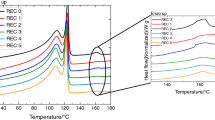Abstract
Batch equilibrium experiments were performed to determine the distribution coefficients for Sc, Ir, and Ta on N,N,N′,N′ tetraoctyl-1,5-diglycolamide (TODGA) resin in various acid matrices. Distribution coefficients were determined in hydrochloric acid (Sc, Ir), nitric acid (Sc, Ta), and a mixture of nitric acid and 0.2 M hydrofluoric acid (Sc, Ir, Ta). The distribution coefficients determined through these experiments were then utilized to create a group separation method for activation products, fission products, and environmental constituents.







Similar content being viewed by others
References
Morley SM, Seiner B, Finn E, Greenwood L, Smith SC, Gregory S, Haney M, Lucas D, Arrigo L, Beacham T, Swearingen K, Friese J, Douglas M, Metz L (2015) Integrated separation scheme for measuring a suite of fission and activation products from a fresh mixed fission and activation product sample. J Radioanal Nucl Chem 304:509–515
Foster DG Jr, Arthur ED (1982) Average neutronic properties of “prompt” fission products. Los Alamos National Laboratory, Los Alamos, NM. https://doi.org/10.2172/5187544
Xiao H, Long C, Tian X, Chen H (2016) Influences of Zr, Ce and Ba fission products on the surface properties of UO2: atomistic simulations. Surf Sci 649:1–6
Metz LA, Friese JI, Finn EC, Greenwood LR, Kephart RF, Hines CC, King MD, Henry KM, Wall DE (2013) Fission products measured from highly enriched uranium irradiated inside a boron carbide capsule. J Radioanal Nucl Chem 296:763–767
Shozugawa K, Nogawa N, Matsuo M (2012) Deposition of fission and activation products after the Fukushima Dai-ichi nuclear power plant accident. Env Pollut 163:243–247
Schwantes JM, Orton CR, Clark RA (2012) Analysis of a nuclear accident: fission and activation product release from the Fukushima Daiichi nuclear facility as remote indicators of source identification, extent of release, and state of damaged spent nuclear fuel. Pacific Northwest National Laboratory, Richland, WA. PNNL-20912. https://doi.org/10.2172/1076730
Nuclear Energy Agency Organisation for Economic Co-operation and Development (2007) Mobile fission and activation products in nuclear waste disposal. In: Workshop proceedings La Baule, France 16–19 Jan 2007. NEA No. 6310. ISBN: 978-92-64-99072-2
Ehmann WD, Vance DE (1993) Radiochemistry and nuclear methods of analysis. United States, N.p. OSTI Identifier: 5968504
Dry DE, Bauer E, Petersen LA (2005) Rapid separation of fresh fission products. J Radioanal Nucl Chem 263(1):19–22
Evans JC, Lepel EL, Sanders RW, Wilkerson CL, Silker W, Thomas CW, Abel KH, Robertson DR (1984) Long-lived activation products in reactor materials. Pacific Northwest National Laboratory, Richland. https://doi.org/10.2172/6776358
Ishikawa T, Sugimoto K, Nagaishi K (2003) Determination of rare-earth elements in rock samples by an improved high-performance ion chromatography. Geochem J 37(6):671–680
Stray H, Dahlgren S (1995) A combined classical ion-exchange and HPIC procedure for the separation of Nd and Sm for isotopic analysis of geological samples. Chem Geol 125(3–4):233–238
Hann S, Koellensperger G, Kanitsar K, Stingeder G (2001) ICP-SFMS determination of palladium using IDMS in combination with on-line and off-line matrix separation. J Anal Atomic Spectrom 16:1057–1063
Meynadier L, Gorge C, Birck JL, Allègre CJ (2006) Automated separation of Sr from natural water samples or carbonate rocks by high performance ion chromatography. Chem Geol 227(1–2):26–36
Pourmand A, Dauphas N (2010) Distribution coefficients of 60 elements on TODGA resin: application to Ca, Lu, Hf, U, and Th isotope geochemistry. Talanta 81:741–753
Ternes TA, Herrmann N, Bonerz M, Knacker T, Siegrist H, Joss A (2004) A rapid method to measure the solid–water distribution coefficient (Kd) for pharmaceuticals and musk fragrances in sewage sludge. Water Res 38(19):4075–4084
Martinez A, O’Sullivan C, Reible D, Hornbuckle KC (2013) Sediment pore water distribution coefficients of PCB congeners in enriched black carbon sediment. Env Pollut 182:357–363
kGil-García CJ, Rigol MV. (2011) Comparison of mechanistic and PLS-based regression models to predict radiocaesium distribution coefficients in soils. J Hazard Mater 197:11–18
Ames LL, McGarrah JE (1980) Basalt-radionuclide distribution coefficient determinations FY-1979 annual report. Pacific Northwest National Laboratory, Richland, WA. https://doi.org/10.2172/6751781
United States Environmental Protection Agency (1999) Understanding variation in partition coefficient, Kd, values. EPA 402-R-99-004A
Chorghe D, Sari MA, Chellam S (2017) Boron removal from hydraulic fracturing wastewater by aluminum and iron coagulation: mechanisms and limitations. Water Res 126:481–487
Demetriou A, Pashalidis I (2012a) Adsorption of boron on iron-oxide in aqueous solutions. Desalin Water Treat 37(1–3):315–320
Yin KM, Lin BT (1996) Effects of boric acid on the electrodeposition of iron, nickel, and iron–nickel. Surf Coat Technol 78(1–3):205–210
Zech N, Landolt D (2000) The influence of boric acid and sulfate ions on the hydrogen formation in Ni–Fe plating electrolytes. Electrochim Acta 45(21):3461–3471
Demetriou A, Pashalidis I (2012b) Spectrophotometric studies on the competitive adsorption of boric acid (B(III)) and chromate (Cr(VI)) onto iron (oxy) hydroxide (Fe(O)OH). Glob Nest 14(1):32–39
Acknowledgements
This work was funded by the Office of Defense Nuclear Nonproliferation Research and Development within the U.S. Department of Energy’s National Nuclear Security Administration. The authors would like to thank Shannon Morley for assistance with gamma analysis, Chelsie Beck for assistance with ICP-OES analysis, and Corey Hines and Mat King at the Washington State University research reactor for facilitating the irradiation. In this section, your results and their interpretation should be given. It can be two separate sections if appropriate.
Author information
Authors and Affiliations
Corresponding author
Additional information
Publisher's Note
Springer Nature remains neutral with regard to jurisdictional claims in published maps and institutional affiliations.
Rights and permissions
About this article
Cite this article
Louie, C., Morrison, E., Thomas, ML. et al. Measurement of distribution coefficients on TODGA resin and development of a group separation for mixed activation and fission product samples. J Radioanal Nucl Chem 326, 1669–1678 (2020). https://doi.org/10.1007/s10967-020-07460-7
Received:
Accepted:
Published:
Issue Date:
DOI: https://doi.org/10.1007/s10967-020-07460-7




